The Sawmill Branch Trail
 Thu, September 10, 2009
Thu, September 10, 2009 
The Sawmill Branch Trail in Summerville, South Carolina, is a bike and walking trail that follows along side the old Sawmill Branch Canal.
The final section is now finished and runs from East Richardson Avenue in the North, close to the center of Downtown Summerville.
From that point there is now close to 7 miles of smooth paved bike path, about 12 or 15 feet wide that will take you to the South End of Old Trolley Road, near Dorchester Road.
Out and back on this trail will give you 14 miles of motor traffic free riding. Where the path crosses the busy Gahagan Rd, Old Trolley Rd, and Bacon’s Bridge Rd, in each case the path goes under a bridge, so there is no stopping or slowing.
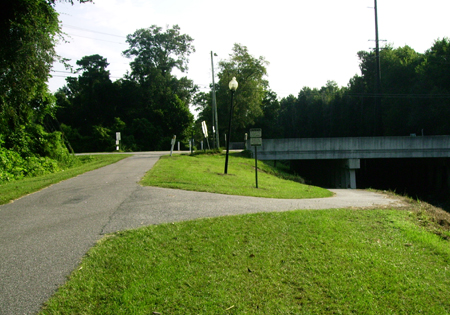
The photo above shows the approach towards the North End of Old Trolley Road.
Here you have the option of going right under the busy four lane Old Trolley and on towards Richardson Ave. Or you can go straight and turn right on Old Trolley; there is a busy intersection at Bacon’s Bridge Rd., but there is a traffic light at this point.
Once past Bacon’s Bridge, Old Trolley Rd., has a bike lane its entire length. You can ride to the South End and turn right on Cross Creek Drive, and join up with the bike trail again. This makes about an 8 or 9 mile loop. (See map below.)
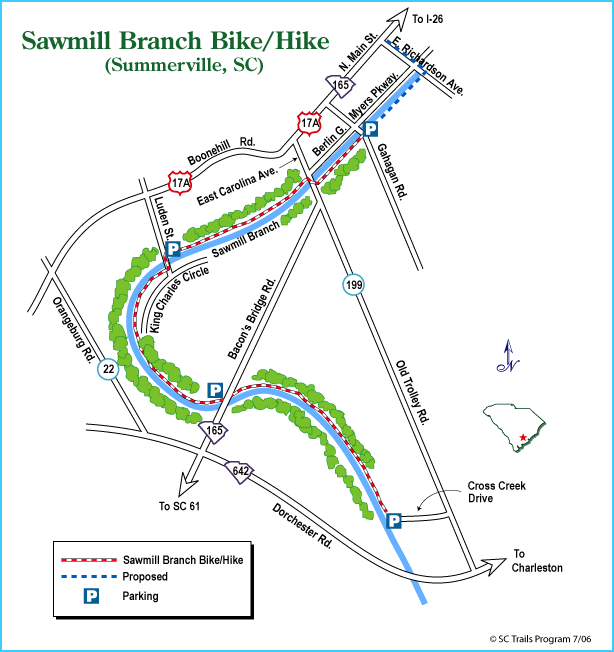
There are 4 different parking areas. My favorite is Luden Street, a quiet residential neighborhood. The trail switches from one side of the canal to the other at this point; don’t go straight across from the car park as the paved trail on that side runs out in about 200 yards.
The trail switches sides at another point just after you go under Old Trolley Road; again this is on a quiet street with little traffic.
A word of warning as you go under the bridges; earlier this summer, some vandals piled large rocks from the canal bank, across the path, under the Old Trolley Rd. Bridge. When you come out of the bright sunlight it is quite dark and hard to see.
An older man, a regular user of the path, hit these rocks, fell heavily, and was hospitalized as a result of his injuries. There was just this one incident and I have since seen the police patrolling the path from time to time.
 Unfortunately, the local kids also love to break glass bottles on the path too, usually thrown from the bridges above.
Unfortunately, the local kids also love to break glass bottles on the path too, usually thrown from the bridges above.
Apart from these unfortunate but somewhat isolated incidents, I can highly recommend this trail.
Much of the trail is shaded by trees, which is great on a hot day. You will see Blue Herons and Egrets in the water.
There are warning signs saying “Alligators may live here.” But I haven’t seen any yet.
Here are some more photos.
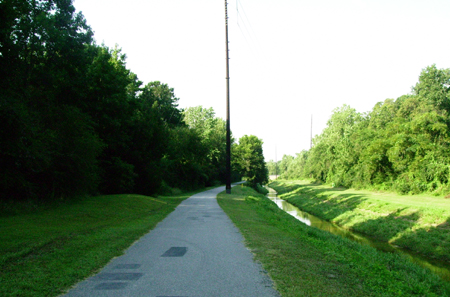

(Above.) Egrets; one of the more common birds you will see on the trail

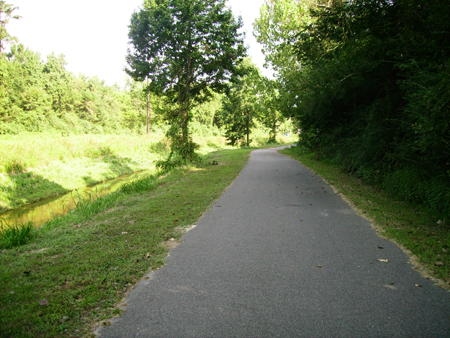
 Dave Moulton | Comments Off |
Dave Moulton | Comments Off | 
















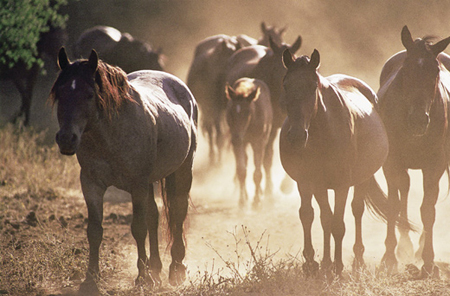




Do cyclists need friends like this?
Prof. John Pucher(Above.) is an urban planner at the Bloustein School of Planning and Public Policy, in New Brunswick, New Jersey.
The professor puts out many articles, reports and studies on urban planning in the US, and how the lot in life for cyclists and pedestrians could be improved in American cities.
His plans call for cities with separate bike and pedestrian paths, and he uses as a model, cities in Germany and Holland. He points out that these two countries have far more cyclists and pedestrians, but fewer deaths and injury for the group.
It would appear that Prof. Pucher is the cyclist’s friend. However, the problem I have with the bold professor is that he uses scare tactics in order to push his own agenda. This is not the first time I have called him out for this, I did so in May last year.
He publishes articles and reports that exaggerate the dangers of cycling, and indeed walking in America, in order to push forward his plans to separate cyclists and pedestrians from motor vehicle traffic.
Because he is an “Expert” in his field, his reports get picked up by mainstream media, who then write articles implying that cycling is dangerous, and suggesting maybe cyclists shouldn’t be on the road.
Articles like this one in the New York Times, and this one from the Christian Science Monitor.
In Prof. Pucher’s report, at the bottom of Page 10, he states that per kilometer traveled, pedestrians in the American cities were 23 times more likely to be killed than in a car. Again based on kilometers traveled, cyclists in the US were 12 times more likely to die than a motorist.
As I pointed out in this previous article, you cannot compare injury and fatality rates based on distance traveled, be they kilometers or miles. Cars travel far greater distances than bicycles or pedestrians. The statistic is so flawed it should be ignored entirely.
The professor’s figures seem awfully high when compared to others I have seen, but whatever figures you use, those based on distance are false.
It is not unreasonable for someone to drive 30 miles to work, whereas a for bicycle commuter 6 miles would be reasonable, and a pedestrian 3 miles. This reduces the risk factor for a bicycle by 5 times, and the pedestrian rate by 10 times.
Also, you can’t compare cycling in Germany or Holland with cycling in American cities. These European countries have always had a cycling culture. People there have grown up riding bicycles, and are used to sharing the road with bicycles.
These countries are about the size of a single state in the US; they were built in the Middle Ages and designed around horse drawn transport. They have been forced to adopt a cycling culture because there is less space to drive, let alone park a car.
A few more bike paths and bike lanes would be nice in our cities, and I am all for Prof. Pucher pushing that aspect. But ultimately three things are going make cycling in the US safer; that is education, education, education.
Education for drivers, education for cyclists. TV ads, billboards, etc. would be money well spent. More cyclists on the road will make it safer, we become more visible, and of course more people on bikes, means less people in cars.
There are approximately 700 cyclists die in the US each year; and that’s 700 too many. However, let’s get that figure in perspective. With a population of over 300 million in the US, this number is quite small. It is less than 2 cyclists a day out of tens of thousands who take to the streets on their bike every day; quite a tiny risk I would say.
Cycling is not as dangerous as some would lead us to believe, especially when you consider the alternative of living a sedentary lifestyle and all the adverse health issues that entails.
I am all for separating bikes and cars on busy thoroughfares if at all possible, but at some point cars and bikes have to come together. Most people manage to make their daily commute in their car without running into other cars, how difficult is it NOT to run into someone on a bicycle?
And so Prof. Pucher, while I applaud your efforts to improve cycling in our cities; if you are a true friend of cycling, knock it off with the scare tactics.
You give fuel for the anti-cycling, “Get them off the road” faction, and you scare people away from riding a bike, at a time when we should be encouraging more bicycle riding.
What are your views? Am I being overly critical of Prof. Pucher? What do you think is needed to improve cycling and cycling safety?